August 1913
| << | August 1913 | >> | ||||
|---|---|---|---|---|---|---|
| Su | Mo | Tu | We | Th | Fr | Sa |
| 1 | 2 | |||||
| 3 | 4 | 5 | 6 | 7 | 8 | 9 |
| 10 | 11 | 12 | 13 | 14 | 15 | 16 |
| 17 | 18 | 19 | 20 | 21 | 22 | 23 |
| 24 | 25 | 26 | 27 | 28 | 29 | 30 |
| 31 | ||||||

August 20, 1913: Stainless steel invented by British metallurgist Harry Brearley (pictured, the stainless steel plaque honoring him)
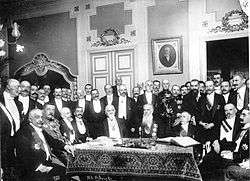
August 10, 1913: Bucharest treaty ends Second Balkan War
.jpg)
August 2, 1913: Mortal men reach the summit of Mount Olympus, home of the Greek gods
.jpg)
August 23, 1913: The Little Mermaid statue assembled in Copenhagen
August 13, 1913: Canadian arctic ship Karluk trapped in ice
The following events occurred in August 1913:
August 1, 1913 (Friday)
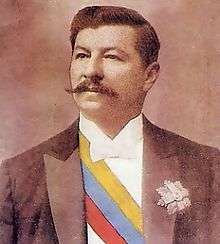
President Gomez
- The federal council of Venezuela authorized President Juan Vicente Gómez to assume dictatorial powers until the revolution led by Cipriano Castro could be suppressed.[1][2]
- Mexico's President Victoriano Huerta announced that he had no intention of resigning.[2][3]
- Russia announced that it would not participate in the Panama–Pacific International Exposition. In doing so, it joined Great Britain, Turkey, Bulgaria, Serbia, Egypt, Morocco and Siam. Another 27 nations had accepted the invitation to participate, including China, France, Japan, the Netherlands, Norway and Sweden, as well as most of the South American and Latin American countries. Austria-Hungary, Germany, Italy and Belgium were among the 15 other invited nations that had not decided on appearing at the Exposition, to open in San Francisco in 1914.[2][4]
August 2, 1913 (Saturday)
- The first known ascent of Mount Olympus in Greece was made by Swiss mountaineers Daniel Baud-Bovy and Frédéric Boissonnas guided by Christos Kakkalos.
- The U.S. Senate Foreign Relations Committee voted 8-4 to reject Secretary of State Bryan's proposal to sign a treaty to make Nicaragua a protectorate of the United States.;[5] Secretary Bryan dropped further discussion of the treaty for the rest of the year.[6]
- Explosions at the East Brookside Colliery of the Philadelphia and Reading Coal and Iron Company mine at Tower City, Pennsylvania, killed 19 people and seriously injured 20. Thirteen men were killed in the blast, and five men who volunteered to be rescuers were killed in a second explosion in the 1,800 foot deep mine shaft.[7][8]
- Pieter Cort van der Linden became the new Prime Minister of the Netherlands.[2][9]
- French aviator Eugène Gilbert became the first person to fly 1,000 miles in a single day to win the semi-annually awarded Pommery Cup. The prize was to be given to the person who "makes the longest flight across country from sunrise to sunset on one day, during which he may stop as often as he wishes to replenish fuel". Gilbert departed Paris at 4:45 am, flew seven hours non-stop to the Spanish town of Vittoria, departed again at 1:00 and arrived at the Portuguese town of Pejabo at 8:00 pm.[10]
August 3, 1913 (Sunday)
- The "Wheatland Hop Riot" began after farm workers at the hops farm at Durst Ranch, near the town of Wheatland, in Yuba County, California, gathered for a meeting with Richard "Blackie" Ford, an organizer for the Industrial Workers of the World union. When the Yuba County Sheriff and his officers arrived to arrest Ford, a crowd of workers rushed the officers. Four people were killed in the melee.[11]
- Died: William Lyne, 69, Australian politician who served as Premier of New South Wales prior to the 1901 creation of the Commonwealth of Australia, and served as Acting Prime Minister from July to September 1907 during the illness of Alfred Deakin
August 4, 1913 (Monday)
- U.S. President Woodrow Wilson asked Henry Lane Wilson to resign as U.S. Ambassador to Mexico, and sent former Minnesota Governor John Lind as his personal representative to attempt a settlement of the Mexican revolution.[12] However, President Huerta said two days later that Lind would not be allowed to enter the country unless he brought an official recognition of the Huerta government. Lind arrived in Mexico City on August 11.
- As the uprising of China's southern provinces collapsed, the Fujian province rescinded its July 20 declaration of independence, and rebel general Xu Chongzhi fled to Japan, returning control of the province to Governor Sun Daoren.[13]
- In fiction, August 4, 1913 marks the climax of the novel The Good Soldier, by Ford Madox Ford
- Joseph Knowles, a 44-year-old survivalist, began his experiment of living alone in "the uncharted forests of northeastern Maine", pledging to "live as Adam lived" for two months. Before a group of reporters, Knowles removed all of his clothes, and walked into the forest without clothing, food or tools. The American press followed his progress by written notes that Knowles left at prearranged locations. Knowles would emerge from the forest on October 4, 1913, wearing a bearskin robe, deerskin moccasins, and a knife, bow and arrows that he had crafted himself.[14] However, there were rumors that Knowles's story was a hoax.[15]
- Born: Robert Hayden, African-American poet, as Asa Bundy Sheffey in Detroit (d. 1980)
August 5, 1913 (Tuesday)
- Pope Pius X reformed longstanding rules of canon law that had restricted the hearing of confession for members of certain religious orders. Previously, confessions could not be heard without prior approval by a superior.[16]
August 6, 1913 (Wednesday)
- John Henry Mears set a new record for traveling around the world, arriving back in New York City after 35 days, 21 hours and 35 minutes. Sponsored by the New York Evening Sun, Mears broke the old record (set by Andre Jaeger-Schmidt in 1911) by four days. Mears, who had departed the newspaper's offices in the early morning hours of July 2 returned to the same spot "at 10:10 o'clock" in the evening five weeks later.[17]
- Venezuela's President Gomez temporarily left office in order to personally lead the nation's army against the rebels of Cipriano Castro. José Gil Fortoul of the Federal Council was designated by Gomez to act as President during Gomez's absence.[18]
- Dr. Sun Yat-sen, the first President of the Republic of China, fled to the island of Taiwan, which at that time was the Japanese colony of Formosa, after being threatened by President Yuan Shikai.[19]
- The Peruvian towns of Caravelí and Quicacha were destroyed by an earthquake that struck the Arequipa Province.[20]
August 7, 1913 (Thursday)
- The Senate of France voted 245-37 to pass the loi de trois ans, extending compulsory military service from two years to three years.[2]
- El Salvador and the United States signed a five-year treaty, pledging to submit all disputes between them "for investigation and report to an International Commission" composed of representatives from five nations. The proposed Commission would have one year to render its report, during which participating nations would withhold from going to war. The agreement was the first of the international peace treaties that Secretary Bryan had proposed in a "plan for world-wide peace".[21]
- Died: Samuel Franklin Cody, 48, American-born British aviator, in a plane crash, along with cricketer William Evans, 30.[22]
August 8, 1913 (Friday)
- Venustiano Carranza, leader of Mexico's rebellion against the government of President Huerta, and Governor of the State of Coahuila, sent a reply to U.S. President Wilson's proposal for a ceasefire until elections could be held in October. Carranza said that he did not recognize President Huerta's authority as legal and that his "comrades in arms in the just defense of our constitutional rights" would continue to fight.[23]
- Born:
- John Facenda, American sports announcer famous for his narration of NFL films; in Portsmouth, Virginia (d. 1984)
- Cecil Travis, American MLB player, in Riverdale, Georgia (d. 2006)
- Axel Stordahl, American musician who arranged the background music for Frank Sinatra, in New York City (d. 1963)
- Robert Stafford, Governor of Vermont, and later its U.S Representative, then U.S. Senator, between 1959 and 1989; in Rutland, Vermont (d. 2006)
August 9, 1913 (Saturday)
- Slightly less than one year before the outbreak of World War One, a diplomat from Austria-Hungary told representatives from Italy and Germany that his Empire intended to plan an invasion of Serbia. The private discussion would be revealed on December 5, 1914, by Italian Prime Minister Giovanni Giolitti, who said that Italy refused to participate.[24]
- Born: Herman Talmadge, American politician and white supremacist who served as Governor of Georgia (1948-1955) and then U.S. Senator (1957-1981); in McRae, Georgia (d. 2002)
August 10, 1913 (Sunday)
- The Treaty of Bucharest was signed at 10:30 a.m., ending the Second Balkan War. Serbia and Greece agreed to withdraw their troops from Bulgaria within three days, and Romania agreed to withdraw from Bulgaria within 15 days. In return, Bulgaria, which had won control of most of the region of Macedonia from Turkey in the First Balkan War, gave up 90 percent of its gains. Serbia increased its size by 80% with the acquisition of northern Macedonia, and Greece increased in size by 68% with the southern half of Macedonia.[25] Bulgaria also ceded Southern Dobruja to Romania, and agreed to demobilize its armed forces immediately. The parties also agreed to submit any future disputes over their borders for arbitration by Belgium, the Netherlands or Switzerland.[26]
- Born:
- Wolfgang Paul, German physicist and 1989 winner of Nobel Prize in Physics, in Lorenzkirch (d. 1993)
- Noah Beery Jr., American TV actor (The Rockford Files); in New York City (d. 1994)
August 11, 1913 (Monday)
- The London ambassadors conference, of Europe's six "Great Powers" (Austria-Hungary, France, Germany, Italy, Russia, the United Kingdom), settled on the boundaries of the new Principality of Albania, created from former Turkish territory by the Balkan League during the First Balkan War. Greece received most of the Chameria, the southern part of the region occupied by the Albanian people, which was incorporated into Epirus, with the capital, Yanina, being renamed as Ioannina.[27] British Foreign Secretary Edward Grey told Parliament the next day that the division of the Albanian people had been made to avoid a war between the Great Powers over the region.[28]
- Twelve workers on the Panama Canal, all but one of them Panamanian, were killed in a sudden rockslide at the quarry at Puerto Bello.[29]
- Born:
- Sir Angus Wilson, British novelist, in Bexhill-on-Sea (d. 1991)
- H. Clay Earles, American auto racing entrepreneur, in Axton, Virginia (d. 1999)
August 12, 1913 (Tuesday)
- The brand name "Oreo" was registered by the United States Patent and Trademark Office for exclusive use by the National Biscuit Company (Nabisco) for its cookies, first marketed on March 6, 1912.[30] Theories of the origin of the name include that it was from the Greek word oros (όρος) (for "mountain"), or the French word or (for "gold"), or the Greek word oraia (ωραία), meaning "nice".[31]
August 13, 1913 (Wednesday)
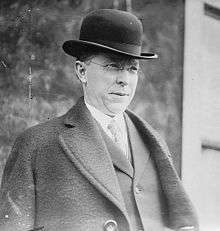
Acting New York Governor Glynn
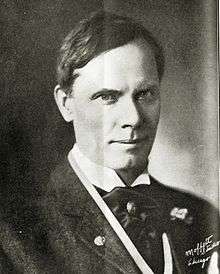
Impeached Governor Sulzer
- After an all-night session, the New York State Assembly voted 79-45 to impeach Governor William Sulzer. The eight articles included accusations of grand larceny, bribery, obstruction of justice, abuse of the public trust, and perjury.[32] Lieutenant Governor Martin H. Glynn became the Acting Governor under state law, as confirmed by the state Attorney General on August 18, although Sulzer said that he would not abandon his office while awaiting his trial in the State Senate on September 18.[33] Sulzer would be found guilty, by a vote of 43-12, on three of the charges, and have removed from office on October 17.[34]
- HMCS Karluk, the flagship for the Canadian Arctic Expedition led by Vilhjalmur Stefansson, became trapped in ice in the Arctic Ocean. The Karluk would drift with the icepack and eventually be crushed by it on January 11; eleven men on the expedition would not survive the search for land.[35]
- Chinese government troops and secessionist rebels fought a battle at Guangzhou (Canton), with 1,200 people being killed.[2]
- The census results for Italy showed a population of 34,671,377.[2]
- Born:
- Fred Davis, English snooker and billiards player; winner of World Snooker Championship 1948-49, 1951, 1952–56; and winner of World Billiards Championship in 1980; in Chesterfield (d. 1998)
- Makarios III, Archbishop and first President of Cyprus (1960-1974); as Michail Christodolou Mouskos in Panagia (d. 1977)
- Died:
- August Bebel, 73, German politician who founded that nation's Social Democratic Party
- Cornelius Moloney, British colonial administrator who governed the imperial colonies that would become Gambia, Nigeria, Belize, and Trinidad and Tobago
- Carlo Bourlet, 47, proponent of the artificial language of Esperanto
- Uriah M. Rose, 79, American jurist whose statue represents Arkansas in the National Statuary Hall Collection in the U.S. Capitol
August 14, 1913 (Thursday)
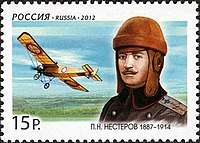
P. N. Nesterov
- In the skies near Kiev, Russian aviator Pyotr Nesterov became the first person to execute a loop, flying his Nieuport IV airplane on an upward pitch until he was upside down, then bringing it back down.[36]
August 15, 1913 (Friday)
- Dr. Albert Schweitzer performed major surgery for the first time at the site of what would become the Albert Schweitzer Hospital at Lambaréné in Gabon, at that time a part of French Equatorial Africa in the jungle. The mission hospital was still under construction, but the patient had a strangulated hernia that required immediate attention. With his wife as the anesthetist, Dr. Schweitzer did the operation in the students' housing at the nearby mission school.[37]
August 16, 1913 (Saturday)
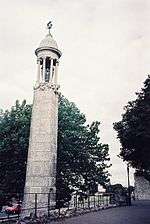
Pilgrim monument
- The English city of Southampton dedicated a monument to the America-bound Pilgrims who had sailed from there on the Mayflower on July 15, 1620.[38]
- Germany became the third major nation to boycott the Panama–Pacific International Exposition.[39]
- Born:
- Menachem Begin, sixth Prime Minister of Israel (1977-1983), and co-recipient of the 1978 Nobel Peace Prize, in Brest, Russian Empire (now Belarus) (d. 1992)
- Ernest "Tiny" Bonham, American All-Star baseball pitcher, who died from surgical complications from an appendectomy, 18 days developing after appendicitis while pitching a game for the Pittsburgh Pirates; in Ione, California (d. 1949)
August 17, 1913 (Sunday)
- The passenger ship State of California struck an uncharted reef off of Admiralty Island in Alaska, and sank within three minutes with 40 of the 179 passengers and crew drowning. The Pacific Coast Steamship Company vessel had been on its way from Seattle to Skagway.[40]
- Harry K. Thaw, the millionaire who murdered architect Stanford White on June 25, 1906, and then was confined to an asylum rather than imprisoned, walked out of the mental hospital at Matteawan, New York and fled to Canada.[41] Thaw would be recaptured, sent back to the hospital and finally be released in 1924, and would die in Florida on February 22, 1947.[42]
- Massachusetts angler Charles Church caught a five foot long, 73 pound striped bass, the largest up to that time. Church's record would stand for almost 58 years as the mark that "remained the goal of every striper fisherman", until July 17, 1981, when Captain Bob Roschetta would reel in a 76-pound bass.[43]
- The Archduke Franz Ferdinand of Austria, heir to the throne of Austria-Hungary, was appointed as Inspector General of that nation's armed forces by his uncle, the Emperor Franz Joseph I. Franz Ferdinand would be assassinated less than a year later, leading to the outbreak of World War One.[44]
- Born:
- W. Mark Felt, American law enforcer and FBI Associate Director 1972-73, identified in 2005 as the secret source for Watergate information whom reporters Bob Woodward and Carl Bernstein identified only as "Deep Throat"; in Twin Falls, Idaho (d. 2008)
- Rudy York, American major league baseball player between 1934 and 1948; in Ragland, Alabama (d. 1970)
August 18, 1913 (Monday)
- At the roulette wheel at Le Grande Casino in Monte Carlo, Monaco, the color black came up 26 times in a row. The probability of the occurrence was 1 in 136,823,184[45] The incident is cited as an illustration of the gambler's fallacy, because after the wheel stopped at black ten straight times, casino patrons began betting large sums of money on red, on the logic that black could not possibly come up again. The odds of red or black coming up on any individual spin were the same each time—18 out of 37; to no surprise of statisticians, "the casino made several million francs that night".[46]
- Venezuela government troops recaptured the town of Santa Ana de Coro, located in the state of Falcón, from the rebels led by former President Cipriano Castro. Two of the rebel leaders, General Lazaro Gonzales and General Urbina, were killed in the battle, while President Castro was able to flee.[47]
August 19, 1913 (Tuesday)
- The derailing of a train carrying dynamite caused an explosion killing almost 100 people in the Mexico City suburb of Tacubaya.[48]
- After his airplane failed at an altitude of 900 feet (270 m), aviator Adolphe Pégoud became the first person to bail out from a falling airplane and to land safely.[49]
- The Turkish council of ministers voted to drop claims to territory west of the Maritza River in return for keeping Adrianople.[50]
- Born:
- Dick Simmons, American TV actor who played the title role in Sergeant Preston of the Yukon, in Saint Paul, Minnesota (d. 2003)
- John Argyris, Greek-born German aeronautical engineer and computer scientist, in Volos (d. 2004)
August 20, 1913 (Wednesday)
- The combination of materials that would become known as "stainless steel was cast for the first time, by British metallurgist Harry Brearley. On test number 1008, at a laboratory in Sheffield, Brearley created an alloy that consisted of 12.8% chromium, 0.44% manganese, 0.2% silicon, 0.24% carbon and 85.32% iron. Brearley would later recount that "When microscopic studies of this steel were being made, one of the first noticeable things was that the usual reagent used for etching the polished surface of a microsection would not etch, or etched very slowly... The significance of this is that etching is a form of corrosion, and the specimens behaved in vinegar and other food acids as they behaved with the etching reagents." [51]
- Dr. Mario Piacenza became the first person to climb Mount Numakum, a 22,000 foot high Himalayan peak.[39]
- Born: Roger Wolcott Sperry, American neurobiologist, and co-recipient of the 1981 Nobel Prize in Physiology or Medicine; in Hartford, Connecticut (d. 1994)
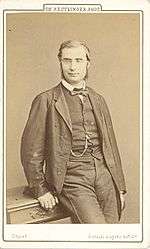
Franco-Prussian War scapegoat Olliver
- Died: Émile Ollivier, 88, Prime Minister of France in 1870. Ollivier was blamed in his obituary for "diplomacy... of the wildest and most unreasonable kind" with German Prussia. He was forced to resign after the outbreak of the Franco-Prussian War, which saw the unification of Germany and the fall of Paris to German troops.[52]
August 21, 1913 (Thursday)
- The San Miguel Corporation, one of the largest food and beverage conglomerates n Southeast Asia, was incorporated in the Philippines.[53]
- Born:
- John Henry Faulk, American radio show host whose career was ruined after he was wrongfully identified as a Communist sympathizer and blacklisted; in Austin, Texas (d. 1990). Faulk later won a $3.5 million verdict against his accusers.
- Robert Krasker, Australian-born British cinematographer, in Perth (d. 1981)
August 22, 1913 (Friday)
- Fifty men, employed at a gold mine in the Mysore State of India, were killed as they were being lowered into the mine shaft. The cable that held their elevator cage broke, sending them plummeting to the bottom.[54]
- As it neared completion, Wolf House, built by author Jack London, was destroyed by a fire before he could move in. "Carefully designed to avert natural disasters and last a thousand years," an author would write later, "it lasted two days." [55] In 1995, a forensic team would conclude that the fire was accidental, caused by the summer heat and the resulting combustion of an oil-soaked rag left behind by a workman.[56]
- Born: Bruno Pontecorvo, Italian nuclear physicist and Soviet spy who defected to the USSR in 1950; in Marina di Pisa
August 23, 1913 (Saturday)
.jpeg)
Den lille havrue
- The famous statue, "The Little Mermaid" (Den lille havrue), sculpted by Edvard Eriksen, was unveiled in Copenhagen at the Langelinie pier, commemorating the fairy tale written by Hans Christian Andersen.[57]
- The Great Northern Telegraph Company signed an agreement with the Empire of Japan, expanding its network of cable communications into Asia.[58]
- Born: Bob Crosby, American singer and musician, in Spokane, Washington (d. 1993)
August 24, 1913 (Sunday)
- English poet Herbert Warren, inspired by Mohandas Gandhi to convert to the Indian religion of Jainism, founded the "Mahavira Brotherhood" in London in hopes of spreading the religion in the United Kingdom and the rest of the western world.[59]
- The city of San Gabriel, California, was incorporated, 142 years after the founding of the Mission San Gabriel Arcángel in 1771,[60] with a population of 1,500 people. One century later, it would have over 40,000 residents.
- Born:
- Charles Snead Houston, American physician and mountaineer, in New York City (d. 2009)
- Lan Jen Chu, Chinese-born American inventor and theoretician in microwave technology; in Huai'an, Jiangsu province (d. 1973)
- Died: E. M. Bounds, 78, American evangelist
August 25, 1913 (Monday)
August 26, 1913 (Tuesday)
- In Ireland, members of James Larkin's Irish Transport and General Workers' Union employed by the Dublin United Tramways Company began a strike in defiance of the dismissal of trade union members by its chairman.[63][64]
- The U.S. peace mission to Mexico ended, when former Governor Lind of Minnesota left Mexico City.[65]
- Died: Edward L. Baker, Jr., African-American winner of the Medal of Honor for heroism during the Spanish–American War
August 27, 1913 (Wednesday)
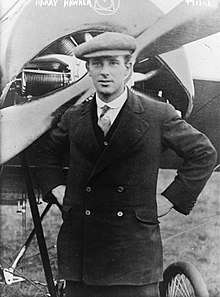
Unlucky pilot Hawker
- British aviator Harry Hawker was two-thirds of the way done with his quest to become the first person to fly an airplane around the British Isles, and slightly less than 500 miles from winning a £10,000 prize ($25,000 in 1913 USD, worth roughly $580,000 or £375,000 a century later), when his plane crashed in an accident blamed on his footwear. Hawker escaped serious injury, but "His boots were rubber-soled, and at a critical moment his foot slipped off the rudder bar" of his seaplane, which went out of control and crashed into the Irish Sea, a few feet from the Irish coast at Loughshinny. Hawker escaped with only a broken arm. The sponsor of the prize, the British newspaper the Daily Mail, presented Hawker with a smaller £1,000 prize "in recognition of his skill and courage. The rubber-soled boots, which cost Hawker the equivalent of half a million dollars, were ruined by the seawater.[66]
- U.S. President Wilson delivered a written message to Congress, proclaiming American neutrality in that nation's civil war, and urged all Americans to leave Mexico. Wilson stated that he would "see to it that neither side to the struggle now going on in Mexico receive any assistance from this side of the border" and that the U.S. could not "be the partisans of either party" nor "the virtual umpire between them".[67]
- A meteor crashed into the Sakonnet River, near Tiverton, Rhode Island. The explosion, which news reports said "sounded like the discharge of a twelve-inch gun", was heard within a 20-mile radius and broke windows in nearby homes.[68]
- Born: Nina Schenk von Stauffenberg, Russian-born wife of German Count Claus von Stauffenberg, who was imprisoned after his 1944 attempt to assassinate Adolf Hitler; in Kovno (now Kaunas), Lithuania (d. 2006)
August 28, 1913 (Thursday)
- At The Hague, Queen Wilhelmina of the Netherlands dedicated the Peace Palace, which would later house the International Court of Justice .[39]
- The New York Yacht Club accepted the fourth challenge by Britain's Sir Thomas Lipton in the America's Cup.[39]
- Born:
- Jack Dreyfus, American financier who founded the Dreyfus Funds; in Montgomery, Alabama (d. 2009)
- Robertson Davies, Canadian novelist, in Thamesville, Ontario (d. 1995)
- Richard Tucker, American tenor,in Brooklyn (d. 1975)
- Boris Pahor, Slavic-language writer, in Trst, Austria-Hungary (now Trieste, Italy) (still alive in 2018)
August 29, 1913 (Friday)
- General Lucio Blanco, rebel commander in the Mexican Revolution, began the redistribution of land in the states of Nuevo León and Tamaulipas.[69]
- Born:
- Jan Ekier, Polish pianist and composer, in Krakau, Austria-Hungary (now Kraków in Poland) (d. 2014)
- Sylvia Fine, American composer and lyricist, in Brooklyn (d. 1991)
August 30, 1913 (Saturday)
- The U.S. Naval Air Service was established upon recommendation of Admiral George Dewey. On January 20, the Pensacola Naval Air Station would be created in Pensacola, Florida.[70]
- French Jesuit priest Pierre Teilhard de Chardin, assisting on the expedition to locate further remains of the Piltdown Man, found a canine tooth that perfectly fit the skull of the alleged early ancestor of homo sapiens.[71]
- Eight men and one woman aboard the tugboat Alice were killed when the boilers exploded as the boat was towing barges on the Ohio River near Coraopolis, Pennsylvania. The force of the blast hurled one of the boilers a distance of 1,600 feet. Six other persons survived and were rescued by a passing steamer, the Harriet.[72]
- Born: Thomas F. Torrance, American theologian, to missionary parents in Chengdu, China; (d. 2007)
August 31, 1913 (Sunday)
- The last barrier to the Pacific side of the Panama Canal was opened with the explosion of 44,800 pounds of dynamite, allowing the Pacific Ocean to flow into the locks at Miraflores. Work began two days later "to remove the last barrier of the Atlantic Channel".[73]
- The city of Nanjing was retaken from rebels by Chinese government troops.[39]
- The Dublin Lock-out strike took a deadly turn when the Dublin Metropolitan Police killed one demonstrator and injured 500 more in dispersing the street-car strike protesters. Thirty people were arrested, including the Irish Transport Union leader, James Larkin, whose attempt to an address the crowd from a hotel balcony was followed by the police intervention.[74] The burial of James Nolan, three days later, was attended by 50,000 people.[75]
- Born:
- Bernard Lovell, British radio astronomer, in Oldland Common (d. 2012)
- Helen Levitt, American photographer, in New York (d. 2009)
- Jacques Foccart, French politician who controlled that nation's policies toward Africa, in Ambrières (d. 1997)
- Ray Dandridge, Negro League baseball player and Baseball Hall of Fame enshrinee who was the first African-American in the minor league American Association; in Richmond, Virginia (d. 1994)

Temporarily unidentified, former Congressman Sullivan
- Died: Timothy Sullivan, 51, former U.S. Congressman and New York City political boss, after being struck and dismembered by a train. Sullivan remained unidentified for several days and was set to be sent to a potter's field for the poor, but was recognized on September 13 by a policeman, after which he received a large funeral.[76]
References
- ↑ "Gomez Dictator to Oppose Castro", New York Times, August 2, 1913
- 1 2 3 4 5 6 7 "Record of Current Events", The American Monthly Review of Reviews (September 1913), pp297-298
- ↑ "Huerta to Stick; No Interference", New York Times, August 2, 1913
- ↑ "Russia Latest To Decline; Joins Seven Other Nations in Refusing — 27 Have Accepted", New York Times, August 2, 1913
- ↑ "Kills Protectorate Plan for Nicaragua", New York Times, August 3, 1913
- ↑ "Nicaraguan Plan Shelved", New York Times, August 4, 1913
- ↑ "Five Rescuers Die with Mine Victims", New York Times, August 3, 1913
- ↑ J. Stuart Richards, Death in the Mines: Disasters and Rescues in the Anthracite Coal Fields of Pennsylvania (The History Press, Feb 28, 2007) p59
- ↑ "To Form a Dutch Cabinet", New York Times, August 3, 1913
- ↑ "Flies 1,030 Miles in a Day", New York Times, August 3, 1913
- ↑ Paul A. Gilje, Rioting in America (Indiana University Press, 1999) p132; Robert Justin Goldstein, Political Repression in Modern America (University of Illinois Press, 1978, 2001) p.90.
- ↑ "Wilson Suggests Plan to Mexico", New York Times, August 5, 1913
- ↑ Joyce A. Madancy, The Troublesome Legacy of Commissioner Lin: The Opium Trade and Opium Suppression in Fujian Province, 1820s to 1920s (Harvard University Asia Center, 2003) pp224-225
- ↑ John F. Kasson, Houdini, Tarzan, and the Perfect Man: The White Male Body and the Challenge of Modernity in America (Macmillan, 2001) p191; Robert D. Gilbreath, Compel: How to Get Others in Your Organization to Think and Act Differently (John Wiley & Sons, 2007) pp52-53; Stanley Rogers, Crusoes and Castaways: True Stories of Survival & Solitude (George G. Harrap & Co., 1932, reprinted by Courier Dover Publications, 2011) p140
- ↑ The 1913 ‘Nature Man’ Whose Survivalist Stunts Were Not What They Seemed. atlasobscura.com, by Robert Moor July 07, 2016
- ↑ "The New Canon Law in Its Practical Aspects: Papers Reprinted from "the Ecclesiastical Review", October, 1917-August, 1918" by Andrew Brennan Meehan, et al., (American Ecclesiastical Review, 1918) p71
- ↑ "Cuts a Slice off Globe-Circling Time", New York Times, August 7, 1913
- ↑ "Gomez Leads 7,000 Against Castro", New York Times, August 6, 1913
- ↑ "Dr. Sun Yat-sen Flees from China", New York Times, August 7, 1913
- ↑ "Serious Shocks in Peru", New York Times, August 9, 1913
- ↑ "First Bryan Peace Treaty Is Signed", New York Times, August 8, 1913
- ↑ "Aviator Cody Killed in a Flight", New York Times, August 8, 1913
- ↑ "Carranza Says Fighting Must Go On; He Will Not Recognize Gen. Huerta", New York Times, August 9, 1913
- ↑ J. Holland Rose, The Origins of the War (Cambridge University Press, 1914) p188
- ↑ Frank Maloy Anderson and Amos Shartle Hershey, Handbook for the Diplomatic History of Europe, Asia, and Africa, 1870-1914 (Government Printing Office, 1918) pp439-441
- ↑ "Allies Sign Peace; Turkey Obstinate", New York Times, August 11, 1913
- ↑ Edwin E. Jacques, The Albanians: An Ethnic History from Prehistoric Times to the Present (McFarland, 1995) p337
- ↑ Tom Gallagher, Outcast Europe: The Balkans, 1789-1989, from the Ottomans to Milošević (Routledge, 2001) p65
- ↑ "12 Die in Panama Slide", New York Times, August 12, 1913
- ↑ "Detailed trademark information from the official US federal trademark database (USPTO): "OREO"
- ↑ David Feldman, Why Do Clocks Run Clockwise?: Mysteries of Everyday Life Explained (HarperCollins, 2009)
- ↑ "Eight Articles of Impeachment Against Gov. Sulzer", New York Times, August 14, 1913
- ↑ "Glynn Governor, Says Carmody", New York Times, August 19, 1913
- ↑ Gustavus Myers, The History of Tammany Hall (Applewood Books, 2012) p376
- ↑ Richard Diubaldo, Stefansson and the Canadian Arctic (McGill-Queen's University Press, 1999) pp82-83
- ↑ Robin D. S. Higham, et al. Russian Aviation and Air Power in the 20th Century (Taylor & Francis, 1998) p92
- ↑ George Nichols Marshall, David Poling, Schweitzer: A Biography (Johns Hopkins University Press, 1971) p110
- ↑ Burton Jesse Hendrick, The Life and Letters of Walter H. Page (Library of Alexandria, 1924)
- 1 2 3 4 5 "Record of Current Events", The American Monthly Review of Reviews (October 1913), pp297-298
- ↑ "Death List Now 40 in Alaskan Wreck", New York Times, August 20, 1913
- ↑ "H. K. Thaw Escapes from Matteawan", New York Times, August 18, 1913
- ↑ Edward Wagenknecht, American Profile: 1900-1909 (University of Massachusetts Press, 1982) p131
- ↑ Al Ristori, The Complete Book Of Surf Fishing (Skyhorse Publishing Inc., 2008) p216
- ↑ Gordon Brook-Shepherd, The Austrians: A Thousand-Year Odyssey (Basic Books, 2002) p151
- ↑ "Roulette", in The Universal Book of Mathematics: From Abracadabra to Zeno's Paradoxes, by David Darling (John Wiley & Sons, 2004) p278
- ↑ Deanna Haunsperger and Stephen Kennedy, The Edge of the Universe: Celebrating Ten Years of Math Horizons (The Mathematical Association of America, 2007) p5
- ↑ "Castro Stronghold Falls", New York Times, August 19, 1913
- ↑ "Explosion Kills 100", New York Times, August 20, 1913
- ↑ "Airman Uses Parachute", New York Times, August 20, 1913
- ↑ "Seeks Only Adrianople", New York Times, August 20, 1913
- ↑ Harold M. Cobb, The History of Stainless Steel (ASM International, 2010) p41
- ↑ "Ollivier, France's War Premier, Dies", New York Times, August 21, 1913
- ↑ SanMiguel.com Archived December 24, 2012, at the Wayback Machine.
- ↑ "Fifty Miners Killed by Cage Fall", New York Times, August 23, 1913
- ↑ Anne Trubek, A Skeptic's Guide to Writers' Houses (University of Pennsylvania Press, 2011) p110
- ↑ Ybarra, Michael (February 4, 1996), "Discovering An Answer In the Flames", New York Times
- ↑ Copenhagen Sights: Travel Guide to the Top 30 Attractions in Copenhagen, Denmark (MobileReference, 2010)
- ↑ Christopher Kobrak and Per H. Hansen, European Business, Dictatorship, and Political Risk, 1920-1945 (Berghahn Books, 2004) p180
- ↑ Helmuth Von Glasenapp, Jainism: An Indian Religion of Salvation (Motilal Banarsidass Publishers, 1999) pp89-90
- ↑ "City of San Gabriel — History"
- ↑ "Frank Sentenced to Die", New York Times, August 27, 1913
- ↑ Michael Newton, The Ku Klux Klan in Mississippi: A History (McFarland, 2010) p65
- ↑ "Dublin Strikers Rioting", New York Times, August 31, 1913;
- ↑ "The Dublin 1913 Lockout", Padraig Yeates, History Ireland (2009)
- ↑ "Lind Declares His Mission Ended", New York Times, August 26, 1913
- ↑ "Rubber-soled Shoe Ends Hawker's Trip", New York Times, August 28, 1913
- ↑ "Wilson's Message; Gamboa's Reply", New York Times, August 28, 1913
- ↑ "Meteor Falls in River", New York Times, August 29, 1913
- ↑ Steven E. Sanderson, Agrarian Populism and the Mexican State: The Struggle for Land in Sonora (University of California Press, 1981) p57
- ↑ "Pensacola Naval Air Station", in Historical Dictionary of the United States Navy, James M. Morris and Patricia M. Kearns, eds. (Scarecrow Press, 2011) p323
- ↑ J. S. Weiner, The Piltdown Forgery, Fiftieth Anniversary Edition (Oxford University Press, 2003) p150
- ↑ "Tug Explosion Kills Nine", New York Times, August 31, 1913
- ↑ "Blast Lets Pacific Reach Canal Locks", New York Times, September 1, 1913
- ↑ "500 Hurt, 1 Dead in Dublin Riots", New York Times, September 1, 1913
- ↑ "50,000 at Burial of Dublin Laborer", New York Times, September 1, 1913
- ↑ "Sullivan, Timothy Daniel", in Political Corruption in America: An Encyclopedia of Scandals, Power, and Greed, Mark Grossman, ed. (ABC-CLIO, 2003) pp312-313; Raymond A. Mohl, The Making of Urban America (Rowman & Littlefield, 1997) p146
This article is issued from
Wikipedia.
The text is licensed under Creative Commons - Attribution - Sharealike.
Additional terms may apply for the media files.